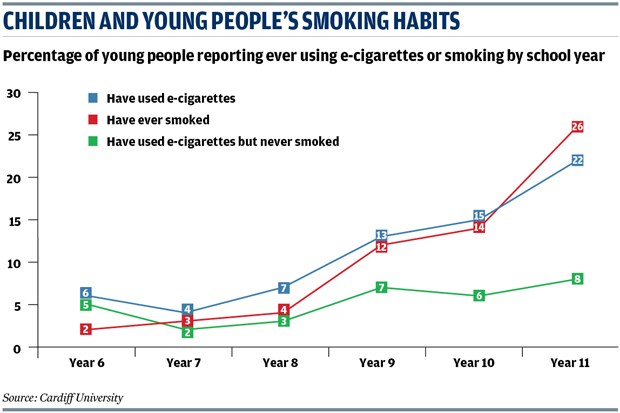Research Report: Electronic-Cigarette Use Among Young People in Wales
Charlotte Goddard
Monday, June 8, 2015
Authors Graham Moore, Gillian Hewitt, John Evans, Hannah Littlecott, Jo Holliday, Nilufar Ahmed, Laurence Moore, Simon Murphy, Adam Fletcher, Cardiff University and University of Glasgow
Published by BMJ Open, April 2015

SUMMARY
Although some evidence shows e-cigarettes can help people who are trying to give up smoking, there are also concerns e-cigarettes could undermine the success of recent anti-smoking strategies, especially those targeted at young people. It has been suggested e-cigarettes could act as a gateway into nicotine addiction and tobacco use for young people, who might use them without being smokers already. The latest generation of e-cigarettes come in a wide range of colours and flavours, which could be attractive to young people.
The research team wanted to estimate the prevalence of e-cigarette use among young people and to find out whether there were links to tobacco and cannabis use. Their analysis combined the findings of two 2014 surveys of 1,601 10- and 11-year-olds and 9,055 children aged between 11 and 16. The children were from 85 secondary schools and 75 primary schools in Wales.
The study - Electronic-Cigarette Use Among Young People in Wales: Evidence From Two Cross-sectional Surveys - found 5.8 per cent of year 6 primary school children had used e-cigarettes with 3.7 per cent using them only once and 2.1 per cent more than once. Fewer than two per cent reported ever having smoked and less than one per cent said they currently smoked.
Among secondary school students, 12.3 per cent said they had used e-cigarettes, but only 1.5 per cent reported using them regularly - at least once a month. Overall, 12.1 per cent of the secondary school students said they had smoked a cigarette, although only 5.4 per cent were current smokers.
When asked if they had ever used cannabis, 7.4 per cent said they had. In secondary school, e-cigarette use was more common than tobacco use until year 11 when it was overtaken by smoking.
In year 6, five per cent of those who had never smoked had tried an e-cigarette. This dropped to two per cent in year 7, before rising throughout secondary school to eight per cent by year 11.
In year 6, 7 and 8 the majority of children who had ever used an e-cigarette said they had never smoked tobacco. Among year 9s, around half of those who had tried an e-cigarette had also smoked tobacco, while in years 10 and 11 the majority of those who had tried an e-cigarette had also tried tobacco. The percentage of those who had used e-cigarettes who were also current smokers rose from 10 per cent in year 6 to 40 per cent by year 11. The odds of regular use of e-cigarettes were 100 times higher among current weekly smokers than among non-smokers and 50 times higher among those who had smoked cannabis.
IMPLICATIONS FOR PRACTICE
The finding that current smoking was strongly associated with e-cigarette use indicates that young people are not adopting e-cigarettes as an effective means of quitting tobacco. The researchers also found that apart from a slightly greater use by boys in primary school, sociodemographic factors such as family affluence and ethnicity play little part in the likelihood of young people using e-cigarettes - unlike in smoking. The researchers suggest their findings show e-cigarette use could potentially spread throughout the youth population and become "normalised", and say policymakers and public health professionals need to keep a close eye on trends in e-cigarette use as the market continues to evolve.
FURTHER READING
- Alternate Tobacco Product and Drug Use Among Adolescents Who Use Electronic Cigarettes, Cigarettes Only, and Never Smokers, Deepa Camenga, Grace Kong, Dana Cavallo, Amanda Liss, Andrew Hyland, Jennifer Delmerico, K Michael Cummings, Suchitra Krishnan-Sarin, Journal of Adolescent Health, July 2014. A US study that aimed to uncover links between use of e-cigarettes, tobacco, alcohol and cannabis.
- E-Cigarette: A New Tobacco Product for Schoolchildren in Paris, Bertrand Dautzenberg, Pierre Birkui, Maryvonne Noel, Johanna Dorsett, Monique Osman, Marie-Dominique Dautzenberg, Open Journal of Respiratory Diseases, February 2013. An investigation into whether the dramatic decrease in price of e-cigarettes encourages Parisian teenagers to use them as a first step to tobacco.
- Electronic Cigarettes and Conventional Cigarette Use Among US Adolescents: A Cross-sectional study, Lauren Dutra, Stanton Glantz, JAMA Pediatrics, July 2014. An examination of links between conventional smoking and the take-up of e-cigarettes using two surveys of 17,-353 and 22,-529 schoolchildren.




